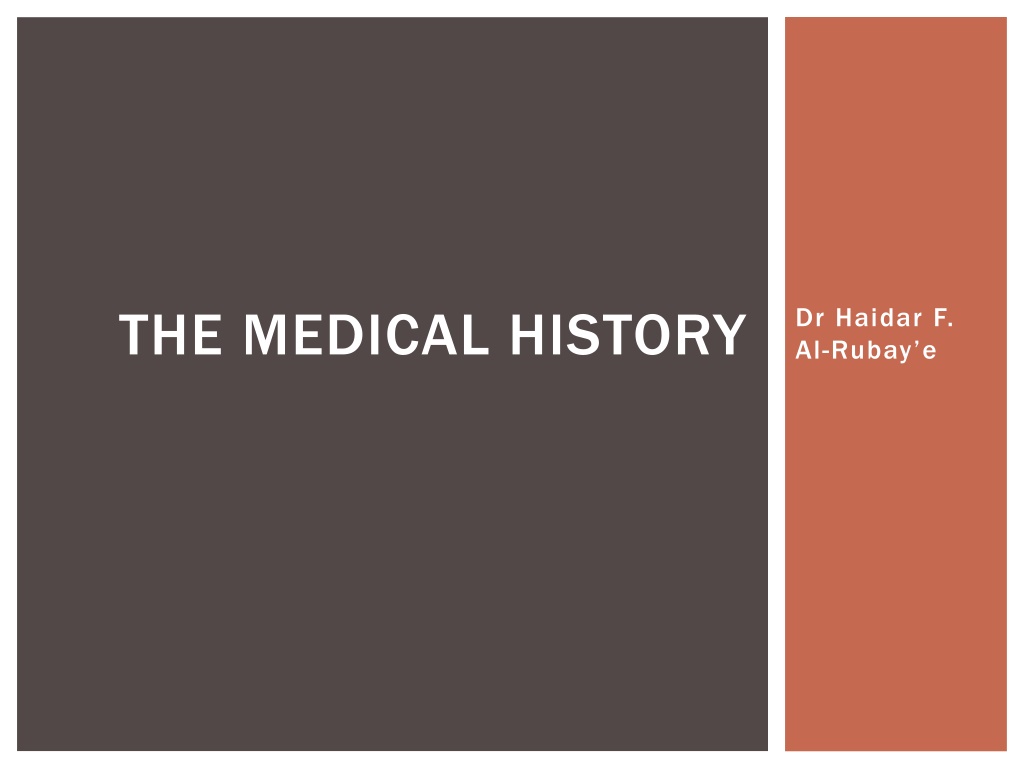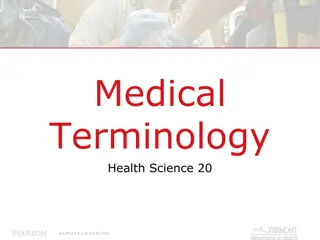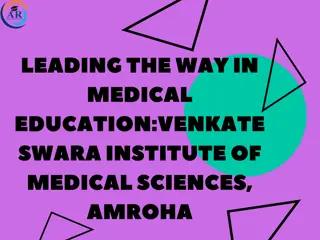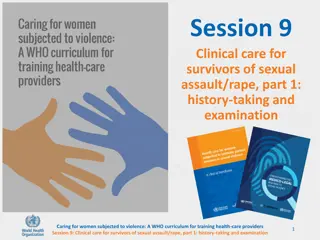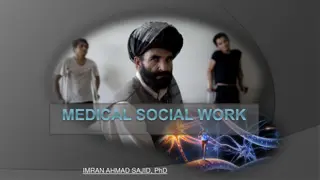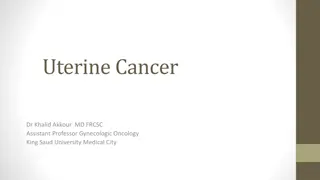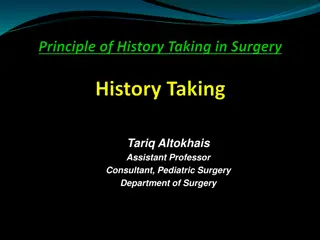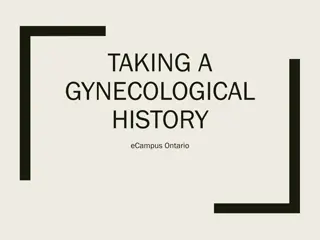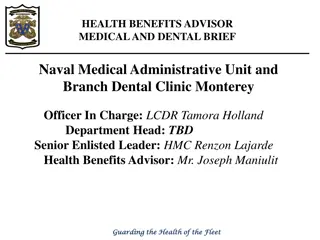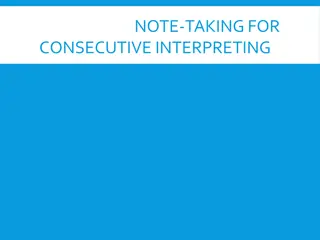Efficient Medical History Taking Guidelines
Medical history taking is a crucial step in diagnosis, involving the patient's account of illness and relevant information. Following a structured framework helps identify potential diagnoses. Key elements include personal information, chief complaint, presenting illness history, review of systems, past medical/surgical history, drug history, family history, and social history. Asking open-ended questions is essential to gather accurate information for creating a list of differential diagnoses.
Download Presentation

Please find below an Image/Link to download the presentation.
The content on the website is provided AS IS for your information and personal use only. It may not be sold, licensed, or shared on other websites without obtaining consent from the author.If you encounter any issues during the download, it is possible that the publisher has removed the file from their server.
You are allowed to download the files provided on this website for personal or commercial use, subject to the condition that they are used lawfully. All files are the property of their respective owners.
The content on the website is provided AS IS for your information and personal use only. It may not be sold, licensed, or shared on other websites without obtaining consent from the author.
E N D
Presentation Transcript
THE MEDICAL HISTORY Dr Haidar F. Al-Rubay e
HISTORY TAKING The history is a patient s account of their illness together with other relevant information that you have gleaned (collected) from them. Like all things in medicine, there is a tried and tested sequence which you should stick to and is used by all practitioners It is good practice to make notes while talking to the patient that you can use to write a thorough history afterwards. Do not write every word they say as this breaks your interaction? By the end of history taking you should have a good idea as to a diagnosis or have several differential diagnosis in mind. The examination and the investigations are you chance to confirm or refute these by gaining more information.
THE STANDARD HISTORY FRAMEWORK You should break the history down under the following headings and record it in the notes in this order: Personal information Presenting (Chief) Complaint History of Presenting Illness Systematic enquiry (Review of Systems) Past medical history & Past Surgical History Drug history Family history Social history
PERSONAL INFORMATION Name Age Gender Address Occupation Marital status Religion!!? Date of admission Date of examination In certain cases- source of information
THE PRESENTING (CHIEF) COMPLAINT This is the patient s chief symptom(s) in their own words and should no more than single sentence Another definition: The main symptom(s) that make the patient seeks medical help. Another definition: The main symptom(s) that bring the patient to the hospital. Features that are required in the chief complaint It is preferable to be one symptom but it is possible to have patient with multiple symptoms and he thinks that all of them are important and are his cause of seeking medical help, if this happen, they must written in one sentence. It must be written using the patient s own terms or words It is not allowed to use medical terms (this feature is applied only for the chief complaint, in the next parts of the history, you can use medical terms) It must include the duration of the chief complaint
It is important to mention that the chief complaint must be written correctly because it is essential to create the list of differential diagnosis. Ask the patient an open ended question like: What s the problem? What made you come to the doctor You should choose a phrase that suits you and your manner.
HISTORY OF THE PRESENT ILLNESS Here, you ask about and document the details of the chief complaint and all of the symptoms that are observed in the patient s current illness So, history of the present illness must include the analysis of each symptom mentioned by the patient and related to his current illness By the end of this you should have a clear idea about the nature of the problem along with how and when it started, how the problem has progressed over time, and what impact it has had on the patient in terms of their general physical health, psychology, social and working lives.
THE HISTORY OF THE PRESENT ILLNESS IS BEST TACKLED IN 2 PHASES: 1stphase Ask an open question and allow the patient to talk through what has happened for about 2 minutes Don t interrupt, encourage the patient with non verbal responses and make discreet notes 2ndPhase This is your chance to verify time lines and the relationship of one symptom to another, clarify pseudomedical terms. You should revisit the whole story asking more detailed questions This should feel like a This should feel like a conversation, not an interrogation conversation, not an interrogation
FOR EACH SYMPTOM DETERMINE: FOR EACH SYMPTOM DETERMINE: The exact nature of the The exact nature of the symptom symptom The onset: The onset: The date it began How it began (e.g. suddenly, gradually-over how long) If long standing, why the patient seeking help now). Periodicity & frequency: Periodicity & frequency: Is the symptom constant or intermittent How long does it last each time What is the exact manner in which it comes and goes. Severity Severity Change over time: Change over time: Is it improving or deteriorating Precipitating factors Precipitating factors is there any factor that initiate the symptom Aggravating factors: Aggravating factors: What make the symptom worse Relieving factor: Relieving factor: What make the symptom better Associated symptoms Associated symptoms
FOR PAIN DETERMINE Site Where is the pain worst Radiation Does the pain moves anywhere else Character i.e. dull, aching, stabbing, burning, etc. Severity Mode & rate of onset Duration Frequency Precipitating factors Aggravating factors Relieving factors Associated symptoms (e.g. nausea, vomiting, dysphagia etc.)
By the end of the history of the present illness, you should have established a problem list. You should run through these with the patient, summarizing what you have been told and ask them if you have the information correct and if there are anything further that they would like to share with you.
SYSTEMATIC ENQUIRY (REVIEW OF SYSTEMS) After talking about the present illness, you should perform a brief screen on the other bodily systems. It is important to find symptoms that the patient had forgotten about, or identifying secondary unrelated problems that can be addressed.
GENERAL SYMPTOMS Weight change (loss or gain) Change in appetite (loss or gain) Fever Lethargy Malaise
RESPIRATORY SYMPTOMS Cough Sputum Hemoptysis SOB Wheeze Chest pain
CARDIOVASCULAR SYMPTOMS Paroxysmal nocturnal dyspnea SOB on exertion Chest pain Ankle/leg swelling palpitations Orthopnea Claudication
GIT SYMPTOMS Abdominal pain Indigestion Nausea Vomiting Constipation Diarrhea Per rectal blood loss Dysphagia
GENITOURINARY SYMPTOMS Urinary frequency Polyuria Dysuria Menstrual problems Hematuria Nocturia Impotence
NEUROLOGICAL SYMPTOMS Headaches Dizziness Tingling Weakness Tremor Fits Faints, syncope Sphincter disturbance
LOCOMOTOR SYMPTOMS Aches Pain Stiffness Swelling
SKIN SYMPTOMS Lumps Ulcers Rashes Itch
PAST MEDICAL HISTORY Some aspects of the patient s past illnesses or diagnoses may have already been covered. (in the beginning of the history of present illness). Here, you should obtain detailed information about past illness and surgical procedures. History of previous admission to hospital must be mentioned For each medical condition, determine: When was it diagnosed? How was it diagnosed? How has it been treated?
PAST MEDICAL HISTORY-ASK SPECIFICALLY ABOUT Diabetes Hypercholestrolemia Hypertension Angina Myocardial infarction Stroke or TIA Asthma TB Epilepsy Anesthetic problems Blood transfusions
Drug history Allergies
SYMPTOMS OF HEART DISEASE Chest pain Dyspnea Palpitations Syncope Fatigue Peripheral oedema.
NEW YORK HEART ASSOCIATION (NYHA) NEW YORK HEART ASSOCIATION (NYHA) FUNCTIONAL CLASSIFICATION FUNCTIONAL CLASSIFICATION Class I Class I No limitation during ordinary activity Class II Class II Slight limitation during ordinary activity Class III Class III Marked limitation of normal activities without symptoms at rest Class IV Class IV Unable to undertake physical activity without symptoms; symptoms may be present at rest
CHEST PAIN Site Differentiating points Radiation. Chest pain is a common presentation of cardiac disease but can also be a manifestation of anxiety or disease of the lungs or musculoskeletal or gastrointestinal systems. Character. Provocation Onset Associated features
PAIN-STANDARD QUESTIONING Site Onset Character Timing (duration, course, pattern) Associated symptoms Radiation Exacerbating and relieving factors Severity
CAUSES OF CHEST PAIN Central Central Peripheral Peripheral Pulmonary Infarction Pneumonia Pneumothorax Lung cancer Mesothelioma Non Non- -pulmonary pulmonary Herpes zoster Trauma (ribs/muscular) Pulmonary Cardiac Cardiac Ischaemic heart disease (infarction or angina) Pericarditis/myocarditis Mitral valve prolapse Aortic aneurysm/dissection Non Non- -cardiac cardiac Pulmonary embolism Oesophageal disease Mediastinitis Costochondritis (Tietze's disease) Trauma (soft tissue, rib)
Site & radiation of ischemic chest pain
SPECIFIC FEATURES OF CHEST PAIN Retrosternal dull ache or discomfort Ill localized Crushing, heaviness, like a tight band Worse with physical or emotional exertion, cold weather and after eating Relieved by rest and nitrates Not affected by respiration or movement Sometimes associated with SOB Angina
The pain is similar to that of angina but it is: More severe More persistent Associated with nausea, vomiting & sweating Associated with Feeling of impending death Myocardial Infarction
Constant retrosternal Worse on inspiration (pleuritic) Relieved slightly by sitting forward Not related to physical or emotional exertion Pericarditis
AORTIC DISSECTION Site Site Often first felt between shoulder blades and/or behind the sternum Onset Onset Usually sudden Nature Nature Very severe pain, often described as 'tearing' Relieved Relieved By nothing, tends to persist; patients often restless with pain Accompanied Accompanied By pallor, sweating, hypertension, asymmetric pulses, unexpected bradycardia, early diastolic murmur, syncope, focal neurological symptoms and signs
Often mistake for MI or angina A severe retrosternal burning chest pain Onset often after eating or drinking May be associated with dysphagia May have history of dyspepsia May be relieved by GTN (needs more time than that required for angina ---20 min Vs 2- 3 min. Esophageal spasm
Retresternal burning pain (heart burn) Relieved by antacids Onset after eating Esophagitis
Sharp pain, worse on inspiration & coughing Not central, may be localized to one side of the chest No radiation No relief with GTN Associated with breathlessness, cyanosis e.g. respiratory symptoms or signs. Pleuritic (respiratory pain)
Localized to particular spot on the chest Worsened by movement and respiration Tender to palpation Musculoskeletal pain
BREATHLESSNESS, SHORTNESS OF BREATH, DYSPNEA Breathlessness (dyspnoea) is an awareness of increased drive to breathe and is normal on exercise. It is pathological if it occurs at a significantly lower threshold than expected. Breathlessness is a non-specific symptom and may be caused by cardiac, respiratory, neuromuscular and metabolic conditions, or by toxins or anxiety.
ORTHOPNEA Orthopnoea is dyspnoea on lying flat and is a sign of advanced heart failure. Lying flat increases venous return to the heart and in patients with a failing left ventricle may precipitate pulmonary venous congestion and pulmonary oedema. The severity can be graded by the number of pillows the patient uses before feeling comfortable ('three-pillow orthopnoea'). Paroxysmal nocturnal dyspnoea is sudden breathlessness which wakes the patient from sleep choking or gasping for air It has a similar mechanism to orthopnoea and is caused by the gradual accumulation of alveolar fluid during sleep. Patients may sit on the edge of the bed and open windows in an attempt to relieve their distress.
CAUSES OF DYSPNEA Left ventricular failure (pulmonary congestion) Pulmonary embolism Dyspnea Any respiratory disease Anxiety
PALPITATION Palpitation is an unexpected awareness of the heart beating in the chest. Patients experience a rapid, forceful or irregular cardiac impulse and describe this as thumping, pounding, fluttering, jumping, racing or skipping. Ask them to tap out the pattern with their fingers to clarify its rate and rhythm. Palpitation may occur in sinus rhythm with anxiety, with intermittent irregularities of the heartbeat, e.g. extrasystoles, or with an abnormal rhythm (arrhythmia). Most patients do not have a sustained arrhythmia and not all patients with arrhythmia experience palpitation; for example, atrial fibrillation commonly causes an irregular heartbeat in the elderly but rarely causes palpitation. The history helps distinguish different types of palpitation. Ask about: onset and termination (abrupt or gradual) precipitating factors (exercise, alcohol, caffeine, recreational or other drugs) frequency and duration of episodes character of the rhythm (ask the patient to tap it out).
DESCRIPTIONS OF ARRHYTHMIAS 'Heart misses a beat' Heart 'jumps' or 'flutters' Ventricular or atrial Ventricular or atrial extrasystoles extrasystoles Heart 'jumping about' or 'racing' Associated breathlessness May be unnoticed Atrial Atrial fibrillation fibrillation Heart racing or fluttering Associated polyuria Supraventricular Supraventricular tachycardia tachycardia Ventricular Ventricular Heart racing or fluttering Associated breathlessness May present as syncope rather than as palpitation tachycardiaVentricular tachycardiaVentricular tachycardia tachycardia
SYNCOPE The term 'syncope' refers to sudden & Transient loss of consciousness due to reduced cerebral perfusion. 'Presyncope' refers to lightheadedness where the individual thinks he or she may black out. There are several mechanisms that underlie recurrent presyncope or syncope: cardiac syncope due to mechanical cardiac dysfunction or arrhythmia neurocardiogenic syncope in which an abnormal autonomic reflex causes bradycardia and/or hypotension. Blackouts can also be caused by non-cardiac pathology such as epilepsy, cerebrovascular ischaemia or hypoglycaemia Cardiovascular disorders produce dizziness and syncope by transient hypotension, resulting in abrupt cerebral hypoperfusion. Recovery is usually rapid, unlike with other common causes of syncope (e.g. stroke, epilepsy, overdose).
POSTURAL HYPOTENSION Syncope on standing upright reflects inadequate baroreceptor- mediated vasoconstriction. It is common in the elderly. Abrupt reductions in blood pressure and cerebral perfusion cause the patient to fall to the ground, whereupon the condition corrects itself.
VASOVAGAL SYNCOPE This is caused by autonomic overactivity, usually provoked by emotional or painful stimuli, less commonly by coughing or micturition. Only rarely are syncopal attacks so frequent as to be significantly disabling ('malignant' vasovagal syndrome). Vasodilatation and inappropriate slowing of the pulse combine to reduce blood pressure and cerebral perfusion. Recovery is rapid if the patient lies down.
CAROTID SINUS SYNCOPE Exaggerated vagal discharge following external stimulation of the carotid sinus (e.g. from shaving, or a tight shirt collar) causes reflex vasodilatation and slowing of the pulse. These may combine to reduce blood pressure and cerebral perfusion in some elderly patients, causing loss of consciousness.
VALVULAR OBSTRUCTION Fixed valvular obstruction in aortic stenosis may prevent a normal rise in cardiac output during exertion, such that the physiological vasodilatation that occurs in exercising muscle produces an abrupt reduction in blood pressure and cerebral perfusion, resulting in syncope.
STOKES-ADAMS ATTACKS These are caused by self-limiting episodes of asystole or rapid tachyarrhythmias (including ventricular fibrillation). The loss of cardiac output causes syncope and striking pallor. Following restoration of normal rhythm recovery is rapid and associated with flushing of the skin as flow through the dilated cutaneous bed is re-established.
